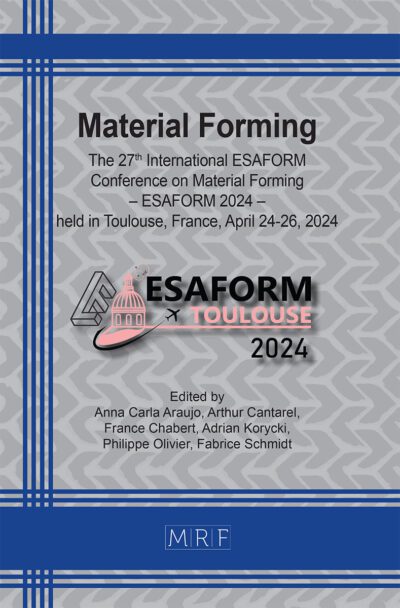Impact of surface engineering on friction stability and forming process variability in automotive components
Toni CHEZAN, Pieter BAART, Javad HAZRATI, Johan PILTHAMMAR
Abstract. This study investigates the integration of advanced multiscale friction models into commercial finite element codes to enhance the predictive accuracy of forming simulations for Zn-coated steel grades in automotive applications. Numerically generated surface topographies representative of industrial materials were employed to evaluate the influence of key parameters, including surface roughness, lubricant quantity, and blank holder force (BHF), on forming performance. Sensitivity analyses were conducted using finite element simulations, with results highlighting the dominant role of BHF in controlling split risks and the comparatively smaller, yet measurable, effects of material-related parameters. The findings reveal discrepancies between traditional friction models and advanced approaches, particularly in capturing the influence of lubricant variability. By offering insights into the interplay between process control parameters and material related properties, the study provides a framework for optimizing forming processes through surface engineering and advanced modeling techniques, addressing challenges posed by variability in material properties and evolving industrial demands.
Keywords
Friction Stability, Surface Topography, Sheet Metal Forming, Lubricant Variability
Published online 5/7/2025, 6 pages
Copyright © 2025 by the author(s)
Published under license by Materials Research Forum LLC., Millersville PA, USA
Citation: Toni CHEZAN, Pieter BAART, Javad HAZRATI, Johan PILTHAMMAR, Impact of surface engineering on friction stability and forming process variability in automotive components, Materials Research Proceedings, Vol. 54, pp 1144-1149, 2025
DOI: https://doi.org/10.21741/9781644903599-124
The article was published as article 124 of the book Material Forming
![]() Content from this work may be used under the terms of the Creative Commons Attribution 3.0 license. Any further distribution of this work must maintain attribution to the author(s) and the title of the work, journal citation and DOI.
Content from this work may be used under the terms of the Creative Commons Attribution 3.0 license. Any further distribution of this work must maintain attribution to the author(s) and the title of the work, journal citation and DOI.
References
[1] M. Sigvant, et al. “Friction in sheet metal forming: Influence of surface roughness and strain rate on sheet metal forming simulation results.” Procedia Manufacturing 29 (2019): 512-519. https://doi.org/10.1016/j.promfg.2019.02.169
[2] A.R. Chezan, et al. “Material variability effects on automotive part production process.” IOP Conference Series: Materials Science and Engineering. Vol. 1284. No. 1. IOP Publishing, 2023. https://doi.org/10.1088/1757-899X/1284/1/012037
[3] J. Hazrati, “Effect of Surface Texture Parameters of Zinc Coated Steel Sheet on its Formability.” ICTMP 2024, Alcoy, Spain, Scientific Books of Abstracts 3 (2024): 38-38.
[4] M. Shisode, et al., “Modeling boundary friction of coated sheets in sheet metal forming” Tribology International 153, 106554 https://doi.org/10.1016/j.triboint.2020.106554
[5] Information on https://www.autoform.com/en/
[6] D. Waanders, et al., “Temperature dependent friction modelling: The influence of temperature on product quality” Procedia manufacturing 47, 535-540 https://doi.org/10.1016/j.promfg.2020.04.159
[7] J. Venema, et al., “Multiscale friction model for hot sheet metal forming” Friction 10 (2), 316-334 https://doi.org/10.1007/s40544-021-0504-6
[8] M. Shisode, et al., “Semi-analytical contact model to determine the flattening behavior of coated sheets under normal load” Tribology International 146, 106182 https://doi.org/10.1016/j.triboint.2020.106182
[9] M. Shisode, et al., “Evolution of real area of contact due to combined normal load and sub-surface straining in sheet metal” Friction 9, 840-855 https://doi.org/10.1007/s40544-020-0444-6
[10] T Mishra, et al., “Modelling of ploughing in a single-asperity sliding contact using material point method” Wear 418, 180-190 https://doi.org/10.1016/j.wear.2018.11.020
[11] T Mishra, et al., “A material point method based ploughing model to study the effect of asperity geometry on the ploughing behaviour of an elliptical asperity” Tribology international 142, 106017 https://doi.org/10.1016/j.triboint.2019.106017
[12] M. Shisode, et al., “Mixed lubrication friction model including surface texture effects for sheet metal forming” Journal of Materials Processing Technology 291, 117035 https://doi.org/10.1016/j.jmatprotec.2020.117035
[13] Scikit-learn: Machine Learning in Python, Pedregosa et al., JMLR 12, pp. 2825-2830, 2011.













